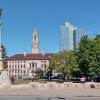The FBI announcement that it knows who stole 13 works of art from the Isabella Stewart Gardner Museum in 1990 comes as a surprise to many. But not to some who have been following this case for years. The FBI has traced the theft to Philadelphia organized crime, and that leaves several questions unanswered.
This was a brazen, well-executed and made-for-Hollywood crime: It required experience, expert planning, and the ability to keep a secret for 20 years. The thieves dressed as cops, took 81 minutes to carry out the crime, and timed it to coordinate with St Patrick’s Day celebrations -- which are 24-hour affairs in Boston. So the key word to think about when trying to get your head around the Isabella Stewart Gardner Museum heist is “organized.” But how organized? And how might the theft be connected to Philadelphia?
“There’s always been sort of a symbiotic relationship between the wiseguys in Philly and the wise guys in Boston,” said Kevin Cullen, who has covered organized crime for the Boston Globe as a columnist and reporter since the late 1980s.
“First of all, both groups have grown up in the shadow of the New York mob,” Cullen said. “And the five families that form the commission, in New York, they more or less run the show. And Philly could not exist without them.”
But one of the lingering questions about the Gardner Museum heist is how could an out of state organization crime group come to Boston without the Boston mob reacting?
“When you say ‘The Irish Mob,’ we’re talking about our old, great friend, Whitey Bulger,” he said. “Whitey had bigger fish to fry around that time, because the state police and the DEA were really putting pressure on him. So everybody has always asked me over the years, ‘Do you think Whitey was involved?’ And I always said no, because Kevin Weeks, Whitey’s second in command – I’ve known Kevin since I was a kid, we’ve always talked – Kevin would have admitted it, he would have been proud of that, if they were involved in that. And Whitey would have shaken them down, whoever it was, for a cut.”
“But Whitey couldn’t shake down Italians,” Cullen added. “But, when you go into the Gardner period, the mafia was in total disarray. Most of what we would call ‘connected guys’ were either in the can, on the run, or they were rats anyway, they were informants for the FBI, so they weren’t getting anything done. I think that’s why the Philadelphia angle makes sense.”
Cullen, who has jut co-authored a new book on White Bulger, says that void in the organized crime scene in Boston made the Museum heist by an outside group possible.
But Former US Attorney Mike Sullivan, who investigated the Gardner Museum Heist, thinks even with Whitey Bulger under duress, any Philadelphia mafia operation in Boston had a clear expiration date.
“Not over a long period of time certainly,” Sullivan said. “There’s not one organized crime group in the city of Boston, there were a number. They did different things in different neighborhoods, and, much as one syndicates organized crime families, they’re essentially controlled by criminal activities in the Greater Boston area. Somebody operating here for a long period of time from outside the state? The answer is no.”
So was this payback of some sort? The Philadelphia mob striking back against its enemies in Boston while their enemy was down?
“I don’t think so, in terms of speculation,” Sullivan said. “The purpose of the heist was one of two things: to sell the art on the black market, there was a market for it, or possibly, for receiving the reward, for the recovery.”
Cullen advanced another theory for who was behind the Gardner Museum heist: the Irish Republican Army.
“I never ruled out the idea the IRA was involved,” he said. “Because, if you go back to that period particularly, the IRA was actively stealing art in Europe. They were stealing art from some of the big mansion houses in Ireland and then fencing it somewhere in Europe. So I never completely ruled that out, but it sounds like the authorities have ruled that out.”
And Cullen says the theft of 13 valuable paintings from a world renowned museum — a meticulous operation that took place when crime families throughout the Northeast, New York and Philadelphia were all in disarray— could only have happened if there was level of cooperation among them.




